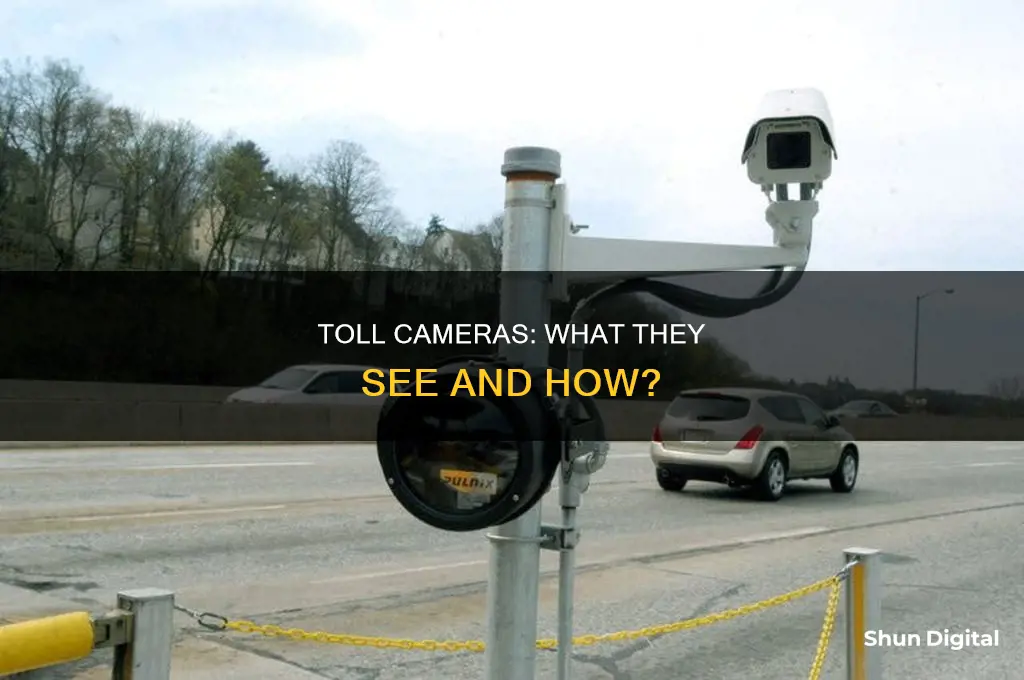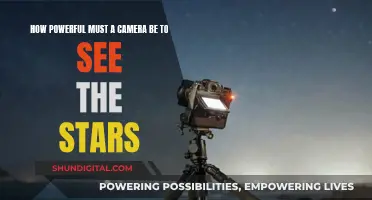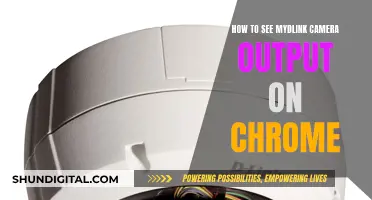
Toll cameras are a common feature of modern roads, and they play a crucial role in collecting tolls, managing traffic, and even aiding law enforcement. These cameras are equipped with automated license plate readers, capturing images and videos of vehicles as they pass through toll gates. While their primary purpose is to ensure accurate billing for tolls, the data they collect has raised privacy concerns among advocates and drivers alike. This data includes not only license plate information but also vehicle speed, axle count, and, in some cases, vague outlines of the vehicle's interior and occupants. With the increasing prevalence of toll cameras, it is important to understand their capabilities and the potential implications for privacy and surveillance.
| Characteristics | Values |
|---|---|
| Camera placement | Mounted on metal frames above toll gantries |
| Image capture | Snap photos of the front and back of each vehicle |
| Video capture | Record a brief video of each vehicle |
| Image resolution | High-resolution |
| Image retention | Images stored for seven years if used for billing, or three months if not |
| Video retention | Videos stored for up to 180 days |
| Data usage | Ensure accurate billing, Identify vehicles with transponders, Capture license plate numbers |
| Speed monitoring | Capable of recording vehicle speed, but not for ticketing |
| Privacy concerns | Advocates worry about sensitive data collection and lengthy record retention |
What You'll Learn

Capturing images of vehicles
The cameras employed in toll collection systems are typically high-resolution, capable of capturing clear and detailed footage. However, there are concerns about the potential invasion of privacy. To address this, state officials have assured that the cameras are not used to view the occupants or other objects inside the vehicle. While the images may show outlines or clothing colours, they do not reveal detailed facial features or other identifiable characteristics. This assertion has been supported by privacy advocates, who emphasise that collecting detailed personal information is unnecessary for toll processing.
In addition to billing purposes, the captured images and videos can also serve other functions. For instance, they can be used to identify the number of axles on a vehicle, as toll rates are often higher for vehicles with more than two axles. The data collected by toll cameras can also include information such as the lane the vehicle was travelling in and its speed. While this speed data is primarily used to synchronise the cameras for accurate license plate recognition, there have been concerns about its potential use for speed enforcement. However, toll operators have stated that the cameras are not used to issue speeding tickets.
The data collected by toll cameras is typically stored for a specific period. For example, the Massachusetts Department of Transportation (MassDOT) stores image files for seven years if they are used for billing and for three months if they are not. The video clips, on the other hand, are retained for up to 180 days. While this retention of records is justified for billing and administrative purposes, privacy advocates have expressed concerns about the length of time such data is stored, highlighting the potential risks to civil liberties and privacy rights.
See-Through Trailers: Chevy's Truck Camera System Explained
You may want to see also

Recording brief videos
Toll cameras are equipped with high-resolution cameras that record brief videos and snap photos of the front and back of each vehicle that passes through the toll gantries. The cameras are installed by companies like Raytheon Co., which reached an agreement with MassDOT in 2014 to install the gantries. The video footage is used to count the number of axles on each vehicle, as toll rates are higher for vehicles with more than two axles. The state's policy is to keep the videos for up to 180 days.
The brief videos are used for toll collection purposes, such as ensuring accurate billing and capturing vehicle license plate numbers. The videos can also be used to identify the lane the vehicle was travelling in and its speed. However, state officials have pledged that speed data will not be used to ticket drivers. The video footage is not used to identify the occupants or other objects inside the vehicle. While the videos may capture a grainy outline of the occupants, their clothing colour, or other general characteristics, they do not show detailed facial features or other identifying information.
Privacy advocates have raised concerns about the length of time that transportation departments store images, videos, and other potentially sensitive toll-related data. In response, some states have adopted policies to address these concerns. For example, MassDOT stores image files for seven years if they were used for billing or for three months if they were not used for billing.
The brief videos recorded by toll cameras are an essential component of the toll collection process, helping to ensure accurate billing and providing additional data such as vehicle speed and lane information. While privacy concerns have been raised, measures are in place to protect the privacy of drivers and occupants, and the video footage is used solely for its intended purpose of collecting tolls.
Smart TV Cameras: Are You Being Watched?
You may want to see also

Tracking speed
While toll cameras are not used to issue speeding tickets, they are still able to track the speed of vehicles. Cameras and sensors work together to capture images of the front and back of a vehicle, even if it changes lanes. This technology has improved significantly over the years, with advancements in high-definition cameras, lower costs, and better software to make sense of the data. In the early 1990s, electronic tolling systems struggled to reliably read a transponder in a car traveling faster than 60 mph. Now, they are virtually 100% accurate with cars going over 100 mph while changing lanes. This accuracy does depend on the transponder being properly mounted, however.
In the case of Virginia's toll roads, if a driver does not have an E-ZPass transponder, cameras on the gantry will snap a picture of the license plate and send those plate numbers to the DMV to obtain the driver's address and send out bills. Transurban, the toll road operator on I-95, I-495, and I-395, has confirmed that their cameras are not used to issue speeding tickets. However, if their team sees anyone driving recklessly, they can alert the police.
Florida's Department of Transportation also relies on automated license plate readers to bill drivers who pass through toll gates without payment transponders, such as SunPass in Florida and EZ Pass in the Eastern US. This technology also powers a surveillance system, known as the Law Enforcement Notification System. Police agencies can request the addition of specific plate numbers to this list, which sends real-time notifications when those vehicles are detected passing through. While this system is primarily used for flagging stolen cars and tracking Amber Alerts, there are concerns about the lack of regulations governing the use of this data and the potential infringement on drivers' civil and privacy rights.
Understanding Maya's Cone of Vision Camera: A Guide
You may want to see also

Surveillance and law enforcement
Toll cameras are a part of an all-electronic tolling system that uses automated license plate readers to bill drivers who pass through toll gates without payment transponders. This technology also powers a surveillance system, known as an enforcement list, black list, or Law Enforcement Notification System (LENS). Police agencies can request the addition of specific license plate numbers or transponder signatures to this list, which then sends real-time notifications when those vehicles are detected passing through.
The system uses high-resolution cameras to capture images and videos of vehicles as they pass through the toll gantries. While the primary purpose of these cameras is to ensure accurate billing for drivers, they have also raised concerns among privacy advocates. The data collected by these cameras, including images, videos, and vehicle speed, is stored for an extended period, ranging from three months to several years, depending on the purpose.
In the case of the Massachusetts Turnpike, the state's Department of Transportation (MassDOT) has stated that the cameras do not capture clear footage of the inside of vehicles. The images and videos are solely used for collecting tolls, and while they may show a grainy outline of the occupants, they do not reveal detailed facial features or other identifying characteristics. However, privacy advocates remain concerned about the length of time the transportation department retains this data.
While toll lane cameras are generally not used for issuing speeding tickets, they can be used to notify law enforcement of reckless driving behavior. For example, if a toll operator observes a driver swerving or driving erratically, they can alert the police, similar to someone calling 911 to report dangerous driving. However, a trooper would still need to directly observe the driver's behavior to issue a ticket.
The use of warrantless surveillance on toll roads has raised concerns among privacy advocates and civil liberties organizations. They argue that the widespread collection of license plate data and real-time tracking pose risks to drivers' civil and privacy rights. In Florida, for instance, there are no laws limiting when or why police can add vehicles to the enforcement list, and the state has refused to disclose information about its toll surveillance program. This lack of transparency makes it difficult for the public to understand how their data is being used and protected.
While law enforcement agencies argue that these systems are essential for investigations and toll enforcement, there is an ongoing debate about finding a balance between public safety and individual privacy rights.
Mastering Camera Views in Cinema 4D: A Guide
You may want to see also

Privacy concerns
The use of cameras for electronic toll collection has raised several privacy concerns. These cameras, installed on toll roads and highways, capture photos and videos of vehicles, including their license plate numbers, to facilitate billing for drivers without transponders. While this technology streamlines toll collection, it also raises questions about the privacy and security of the collected data.
One of the primary concerns is the potential for government overreach and abuse of power. Without proper regulations, law enforcement agencies can access and utilize this data with minimal restrictions. For instance, in Florida, police agencies can request the addition of specific plate numbers to a "black list" or "Law Enforcement Notification System," which provides real-time notifications when those vehicles are detected. While this system can be useful for tracking stolen cars or Amber Alerts, the lack of laws governing its use gives law enforcement unrestricted access to information about individuals' movements and habits.
Additionally, there are worries about the retention and security of the collected data. Transportation departments store images, videos, and other sensitive information for extended periods, ranging from months to years. This data includes details such as the number of axles on a vehicle and their speed. While state laws offer some protection for tolling data, such as exempting customer tolling records from public record requests, the data can still be obtained via subpoena. The lengthy retention of this data increases the risk of it falling into the wrong hands, as centralized databases are attractive targets for hackers.
Privacy advocates emphasize the need for transparency and accountability in the use of toll camera data. They argue that the public has a right to know exactly what information is being collected, how it is being used, and what measures are in place to protect their privacy. Without clear guidelines and restrictions, there is a risk of this data being used for purposes beyond toll collection, such as surveillance or profiling.
Furthermore, while state officials claim that the cameras do not capture clear footage of vehicle interiors or occupants, high-resolution cameras can still record grainy outlines, clothing colors, and other non-identifying characteristics. This level of detail, combined with location and speed data, can paint a comprehensive picture of an individual's movements and habits, potentially infringing on their privacy and freedom.
Tips to Feel Confident and Comfortable on Camera
You may want to see also
Frequently asked questions
Toll cameras use automated license plate readers to record the number plates of vehicles passing through toll gates. They also capture a brief video and images of the front and back of the vehicle.
No, toll lane cameras cannot be used to issue speeding tickets. However, if a driver is seen to be driving recklessly, the camera operators can alert the police.
The data from toll cameras is used to ensure drivers are billed accurately. However, privacy advocates have raised concerns about the length of time that transportation departments store images, videos, and other potentially sensitive data.







